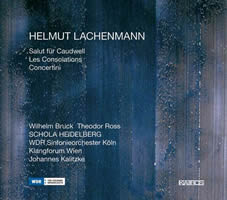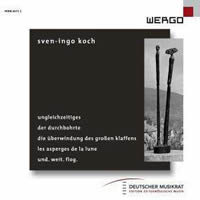An Enigma of Germans
|
Dan Albertson [August 2009.] [With gratitude to Valeria Elli, Petra Kamlot, Markus Kritzokat and Frank Reinisch — and to David Applebaum and Steve Burr for a birthday serenade. D.A.]
Helmut LACHENMANN: Salut für Caudwell* (1977); Les Consolations** (1967-78); Concertini*** (2004-05). Wilhelm Bruck, Theodor Ross* (gui, vv); SCHOLA HEIDELBERG**, Walter Nußbaum (cond.)**, WDR Sinfonieorchester Köln**, Klangforum Wien***, Johannes Kalitzke (cond.)** & ***. KAIROS 0012652KAI (http://www.kairos-music.com/). Distributed in the US by Allegro Music (http://www.allegro-music.com/). The latest offering in the KAIROS Lachenmann series has a famous work, an obscure work and a new work, spread across two discs but offering only 94:47 of music. The 25-minute Salut is Lachenmann at his most minimal and the performance, a new recording by the work’s original performers speaking and exploiting their guitars, is finely characterized and wonderfully captures the descent into scordatura. The duo’s original recording for col legno, some 20+ years ago, must be obsolete by now. I have always had an ambivalent relationship with the piece, finding it somewhat limited in effect, perhaps because it is so laden with affects. Les Consolations, never commercially recorded and seldom performed, serves as both prologue to the two Consolations and prelude to his music-theatre work Das Mädchen mit den Schwefelhölzern. The experience here is expectedly uneven, a sure sign of the more than decade-long gestation. The piece has the two Consolations the Heidelberg singers recorded ten or more years ago for the same label (0012202KAI) interpolated amongst a Präludium, Interludium and Postludium. Literal word-painting and outrageous extremes of onomatopoeia feature at times here, much more than a composer of the seconda prattica could have imagined. Such passages seem more like pièces caractéristiques than cogent contributions of their own. The choristers are committed, however unwieldy the demands; in its Postludium, more than in any other Lachenmann moment, the influence of Dieter Schnebel’s Maulwerker is blatantly apparent. Concertini is for a chamber orchestra of sorts: eight winds, six brass, harp, guitar, piano, four percussionists and seven strings. At 37 mins. it is quite expansive, though the present performance is much quicker than earlier experiences I have had, which veered closer to 45. I remain convinced that the work has too much content for its own good, sundry finely argued solo moments and hefty, never airy, passages and cascades alternating with very introspective, subterranean rêveries. The Lachenmann soundworld remains intact, but with many reminiscences: the episodic nature, and indeed balance between extremes, of the brief orchestral work Tableau; the clarinet gestures from Dal niente (Intérieur III); the bravura piano moments from Ausklang; the sustained string textures from III. Streichquartett, “Grido,” etc., but perhaps with no great unifying link. I admire the courage of such a work, no more than a lengthy parade of memorable scenes, the contents of which are all left to one’s ears and imagination. Their many qualities aside, these CDs seem reserved for Lachenmann devotees only.
Sven-Ingo KOCH: Ungleichzeitiges* (2006); Der Durchbohrte** (2004); Die Überwindung des großen Klaffens (Räume — Bewegungen)*** (2003-04); les asperges de la lune+ (2005); Und. Weit. Flog. (Räume — Bewegungen)++ (2001-02, rev. 2005-07). Chen Halevi (cl)+, Peter von Wienhardt (hpd)*, Dirk Rothbrust (perc)**, Neue Vocalsolisten Stuttgart***, Ensemble Polyphonie T*, Manfred Schreier (cond.)*, musikFabrik**, Titus Engel (cond.)**, Radio-Sinfonieorchester Stuttgart des SWR++, Johannes Kalitzke (cond.)++. Deutscher Musikrat/WERGO WER 6573 2 (http://www.wergo.de/). (No US distributor.) I have had many introductions since the late 1980s through the Deutscher Musikrat discs, some quite good (Hans-Jürgen von Bose [!], Michael Denhoff, Walter Zimmermann and Helmut Zapf immediately come to mind) and some quite bad (Claus-Steffen Mahnkopf, anyone?), but all valuable for the exposure of ideas. Sven-Ingo Koch, born in 1974, is among the newest. Often I have expressed dismay at the lack of curiosity in the generation of composers born in the 1960s and ’70s and (irrational?) exuberance when I find an artist who avoids such a designation by daring to think independently. Koch is a student of Nicolaus A. Huber and Brian Ferneyhough. While his sound owes somewhat to the former, obvious associations to the latter are not readily audible, at least not in these pieces. He cites Ives and Mahler as exemplars for their treatment of disparate materials and aims in his own music to engender a “dissonant montage” founded on the constant juxtaposition of various musics. This technique is persuasive only on occasion. Ungleichzeitiges is unusually scored for concertante harpsichord with a ripieno group of two clarinets, two trumpets, trombone, viola, cello, harmonium, organ and two percussionists. As is often the case in concerted works, the soloist has the least appealing part: some mild, Baroque-inspired ornaments among mostly quiet, inconspicuous music. He is instructed, as the title suggests, to perform without regard to ensemble synchronicity. The composer has written of “mutual non-acknowledgment,” yet the piece’s multiple instrumental layers seem cohesive. Spatial in orientation, it is written for the Petrikirche in Mülheim, but the results are clear enough in a home setting. Though Der Durchbohrte lists a drumset as the solo instrument and an electric guitar among the accompanying decet, anyone expecting a jazz- or pop-tinged experience is sure to be disappointed. The emphasis is on the whispered and the suggested rather than the declared; one hears murmurings from Dante toward the beginning and the soloist plays most often with brushes or on aluminum flowerpots. Taped intrusions are oblique but superfluous nonetheless. The constraint is worthy of praise. The only vocal excursion on offer is Die Überwindung des großen Klaffens (Räume — Bewegungen), with soprano, mezzo-soprano, countertenor, tenor, baritone and bass paired with sounds realized at GRAME and real-time electronics. The piece has no text and not much direction. les asperges de la lune proves unsuccessful, the fate of many wind solos. A mere 10 mins., the score seems too long and quickly grows formulaic, with chalumeau explorations often followed by more shrill passages. Pure dialectics should be more rewarding. Und. Weit. Flog. (Räume — Bewegungen) is a wasted opportunity for the orchestra, which is treated in quite a pallid manner. The piece, already revised on numerous occasions and again after this recording, features haphazard diary entries read by Koch about his experiences at Stanford University, a layer that adds naught to the musical discourse. Often the best music conceals, rather than celebrates, its humble origins. As for the discourse itself, the instrumentation is bland and nondescript, the gestures unremarkable and the overall experience deficient. Some young composers react with overexuberance to an orchestral commission, but Koch seems to have responded with a surfeit of possibilities, none particularly promising in this incarnation. Maybe further revisions will yield a tighter, more compelling argument. I will be sure to follow Koch as he continues to grow.
Bernd Alois ZIMMERMANN: Concerto* (1950); Canto di speranza** (1952-57); Ich wandte mich und sah an alles Unrecht, das geschah unter der Sonne*** (1970). Thomas Zehetmair (vn)*, Thomas Demenga (vc)**, Andreas Schmidt (B)***, Gerd Böckmann & Robert Hunger-Bühler (spkrs)***, WDR Sinfonieorchester Köln, Heinz Holliger (cond.). ECM New Series 2074 (http://www.ecmrecords.com/). Bernd Alois Zimmermann (“Bazi”) is enjoying a revival at the moment, though this disc is a disappointment, despite the mighty names involved. One will immediately notice what an oddity the programming is, with an early work, a transitional work and the last work, the final page of whose score is dated “5.8.1970,” only five days before the composer’s death. This sequence proves unconvincing and these 2005 performances, only recently released, seem mostly disengaged. The Violin Concerto is the exercise of a composer looking for a style and never finding one. As such, the piece is typical of West-German music at the time. Despite its many charms the concerto could not claim to be an essential work in the Zimmermann catalogue. The versatile Zehetmair seems quite comfortable throughout. In the English text, the veteran translator Dr. Robinson has curiously changed the original soloist in this concerto, Hans Stanske, into a “cellist,” perhaps a Freudian slip. The piquant Canto, a quasi-concerto marked as a cantata, has been recorded some 15 years ago by Heinrich Schiff and Michael Gielen, Bazi’s frequent collaborator (Philips, O/P) and quite recently by Peter Hirsch with soloist Lucas Fels (WERGO WER 6656 2). None of these three recordings is distinct enough to be the frontrunner, by which I mean that the work itself excels in all three. The work lacks the extroversion of the later Concerto en forme de ‘pas de trois’ for Siegfried Palm. Instead, the Canto is indeed a “song of hope,” or at least an attempt at one, because true optimism is never found. The solo cello has wonderful sinew and the accompaniment shows much of the invention that Zimmermann developed in his last decade. Ich wandte mich…, an ecclesiastical action, seems almost genteel here. The work may have been inspired by Fluxus, yet seldom was Fluxus proper so sublime. The orchestration is bright and varied, but somewhat coyly performed. Indeed, the electric guitar, expanded brass section and important hammer and nail make little impact at all. Toward the end, the conductor turns away from his flock, covers his face and sits in meditation with his two speakers, waiting to cue the steady Schmidt with his final protestation of woe. I was expecting to be overwhelmed here, but was not. Whether the issue is one of the score or of the performance, I am uncertain. To close, trumpets and trombone intone J.S. Bach’s Es ist genug from O Ewigkeit, du Donnerwort (not the more famous Ich habe genug). The beginning and end are wondrous, but I need some persuasion in between. Alas, the only comparison (Stradivarius STR 33340, 1994) has vanished.
“There are two kinds of music; Germanmusic and bad music.” — H.L. Mencken
[More Dan Albertson]
[Previous Article:
Kurtág’s Játékok, et al.: Hungarian Holiday 2.]
[Next Article:
Album Tweets 1.]
|


